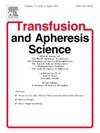Identification of novel RASGRP2 mutations in patients with platelet dysfunction
IF 1.2
4区 医学
Q4 HEMATOLOGY
引用次数: 0
Abstract
Background
Inherited platelet function disorders (IPFDs) are rare hereditary diseases characterized by dysregulation of genes related to platelet receptors expression or signal transduction pathways. Bleeding disorder platelet-type 18 (BDPLT18) is an infrequent autosomal recessive platelet function disorder caused by RASGRP2 mutation. The RASGRP2 gene encodes calcium- and DAG-regulated guanine exchange factor-1 (CalDAG-GEFI), which plays a role in the activation of the αIIbβ3 integrin in platelets. In present study, eleven unrelated patients were examined for mutational analysis to identify mutations in RASGRP2 gene that may lead to BDPLT18.
Methods
The study included 11 unrelated cases (6 males and 5 females) with various bleeding disorders in 2024. The patients were selected based on normal expression of CD41, CD61, and CD42b, as well as an impaired response to ADP, collagen, and arachidonic acid. The plasma coagulation parameters of the patients were normal. Polymerase chain reaction (PCR) and sanger sequencing were used to screen for mutations in the RASGRP2 gene.
Results
A total of 7 mutations were identified in the patients. Including four novel missense mutations (RASGRP2: p.F497L, p.F501L, p.N505K, p.C515G) and 3 known mutations (RASGRP2: p.D441N, p.R494Afs*54, g.10410 G>T). These mutations are predicted to cause disease and alter the characteristics of the CalDAG-GEFI protein.
Conclusion
Identifying RASGRP2 gene mutations and their association with bleeding episodes is crucial for confirming the diagnosis of BDPLT18, distinguishing it from other platelet disorders, and using effective therapeutics to prevent bleeding abnormalities.
血小板功能障碍患者新RASGRP2突变的鉴定
遗传性血小板功能障碍(ipfd)是一种罕见的遗传性疾病,其特征是与血小板受体表达或信号转导途径相关的基因失调。血小板18型出血障碍(BDPLT18)是一种罕见的常染色体隐性血小板功能障碍,由RASGRP2突变引起。RASGRP2基因编码钙和dag调控的鸟嘌呤交换因子-1 (CalDAG-GEFI),在血小板αIIbβ3整合素的激活中起作用。在本研究中,我们对11名不相关的患者进行了突变分析,以确定可能导致BDPLT18的RASGRP2基因突变。方法选取我院2024年11例不相关的各种出血性疾病患者(男6例,女5例)作为研究对象。患者是根据CD41、CD61和CD42b的正常表达,以及对ADP、胶原和花生四烯酸的反应受损来选择的。患者血浆凝血指标正常。采用聚合酶链反应(PCR)和sanger测序技术筛选RASGRP2基因突变。结果共检出7个突变。包括4个新的错义突变(RASGRP2: p.F497L, p.F501L, p.N505K, p.C515G)和3个已知突变(RASGRP2: p.D441N, p.R494Afs*54, g.10410 G>;T)。预计这些突变会导致疾病并改变CalDAG-GEFI蛋白的特性。结论确定RASGRP2基因突变及其与出血发作的关系,对于确定BDPLT18的诊断、区分其与其他血小板疾病,以及采用有效的治疗方法预防出血异常至关重要。
本文章由计算机程序翻译,如有差异,请以英文原文为准。
求助全文
约1分钟内获得全文
求助全文
来源期刊
CiteScore
3.60
自引率
5.30%
发文量
181
审稿时长
42 days
期刊介绍:
Transfusion and Apheresis Science brings comprehensive and up-to-date information to physicians and health care professionals involved in the rapidly changing fields of transfusion medicine, hemostasis and apheresis. The journal presents original articles relating to scientific and clinical studies in the areas of immunohematology, transfusion practice, bleeding and thrombotic disorders and both therapeutic and donor apheresis including hematopoietic stem cells. Topics covered include the collection and processing of blood, compatibility testing and guidelines for the use of blood products, as well as screening for and transmission of blood-borne diseases. All areas of apheresis - therapeutic and collection - are also addressed. We would like to specifically encourage allied health professionals in this area to submit manuscripts that relate to improved patient and donor care, technical aspects and educational issues.
Transfusion and Apheresis Science features a "Theme" section which includes, in each issue, a group of papers designed to review a specific topic of current importance in transfusion and hemostasis for the discussion of topical issues specific to apheresis and focuses on the operators'' viewpoint. Another section is "What''s Happening" which provides informal reporting of activities in the field. In addition, brief case reports and Letters to the Editor, as well as reviews of meetings and events of general interest, and a listing of recent patents make the journal a complete source of information for practitioners of transfusion, hemostasis and apheresis science. Immediate dissemination of important information is ensured by the commitment of Transfusion and Apheresis Science to rapid publication of both symposia and submitted papers.

 求助内容:
求助内容: 应助结果提醒方式:
应助结果提醒方式:


